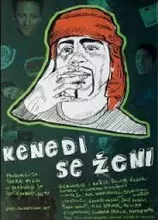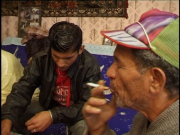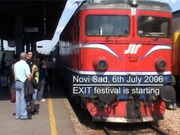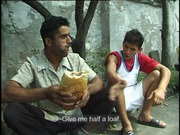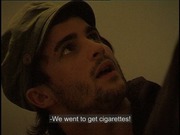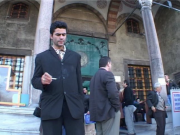Sinopsis:
- Kenedi debe mucho dinero tras construirle una casa a su familia. En la infructuosa búsqueda de trabajo, decide hacerse gigoló, ofreciendo primero sus servicios a señoras mayores y viudas, para luego llegar hasta hombres pudientes. Cuando se entera de la entrada en vigor del matrimonio homosexual en algunos países de la Unión Europea, ve la oportunidad para emigrar de forma legal, y así conocerá a Max, un alemán.
En Zilnikzelimir se escribió:Kenedi is in a huge debt after building a house for his family. He finds himself searching for any kind of work to support himself, for as little as 10 EUR per day, a scarce amount to help him relief his debt. Ultimately, Kenedi decides to look for money in sex business. Initially offering his services to older ladies and widows, he expands his ‘business’ to offer sex to wealthy men. When he finds out about new liberal European laws on gay marriages, Kenedi sees prospects in looking for a “marriage material”, to renew his search for a legal status in EU. The opportunity arises during EXIT Music Festival, when he meets Max, a guy from Munich. But will their promising relationship bring the solution to Kenedi’s problems?
En "Želimir Žilnik: presencias y ausencias", en Blogs and Docs, escribió:(...) En la retrospectiva pudimos ver sus inicios con la estética observacional (siempre atenta a los márgenes de la sociedad) con varios cortometrajes documentales hechos en 1968: "The Unemployed" ("Nezaposleni Ljudi"), "June Turmoil" ("Lipanjska Gibanja") sobre las manifestaciones estudiantiles tras la represión soviética de la primavera de Praga finales de los 60, así como "Little pioneers" ("Pionori Maleni"). También pudimos ver "Black Film" ("Crni Film"), una de sus obras más controvertidas por su utilización de varios indigentes para representar la moraleja de su film: los cineastas os miramos, nos compadecemos y os abandonamos. Además, algunos filmes más recientes se sumaban a la muestra, destacando la interesantísima "Kenedi goes Back Home" ("Kenedi se vraća kući", 2003), primera película de la trilogía que sigue a un joven gitano que se crió en Alemania como refugiado de la guerra, y de la noche a la mañana es expulsado junto a otras muchas familias procedentes de Yugoslavia a una Serbia donde no tienen casa, trabajo o incluso capacidad de comunicarse en serbio, ya que su idioma ahora es el alemán. Alejándose del paternalismo compasivo que criticaba en "Crni Film", Žilnik sigue a Kenedi, que se encarna a sí mismo en muchas escenas reconstruidas. Se echaron de menos las otras dos películas que siguen las visicitudes de la vida del protagonista ("Kenedi, Lost and Found"/"Gde je bio Kenedi 2 godine?", 2005 y "Kenedi is Getting Married[/b][/i]/ "Kenedi se zeni", 2007), y el documental realizado para la televisión en 1994 "Tito’s Second Time among the Serbs"/"Tito po drugi put među Srbima", una vuelta de tuerca al docudrama, donde a través de un actor Žilnik resucita al dictador Tito para confrontarse con la población de una Yugoslavia ya extinta. (...)
Jurij Meden, en "Želimir Žilnik's Kenedi Trilogy: Solidarity Outside the Walls of Fortress Europe", escribió:While Europe is proudly and brashly expanding in line with its sterile, politically correct guidelines on the grounds of an artificial (indeed phoney) and paradoxical concept of "European identity", invisible and impenetrable walls are shooting up along its borders, spreading like a cancer throughout regions beyond the fortress. Just as invisible as those walls are the numerous stories of the peoples left "outside". Thanks to Želimir Žilnik, a rare breed of a filmmaker who (still) believes that cinema can (also) act as a weapon of social intervention, certain dark corners of Europe’s backyard are being exposed, certain otherwise invisible stories are being made visible, and, in the case of Želimir Žilnik, rendered palpable... and even piercing.
His trilogy of films chronicling four years of the life of a certain Kenedi Hasani – an uprooted Rom, a kind, witty, resourceful and almost pathologically optimistic street rat, a true cosmopolitan – represents an example of a political cinema par excellence and a key contribution to the socially engaged cinema of the Balkans in the last decade. No less importantly, it also seems to represent a pinnacle of Žilnik’s recent oeuvre that adheres to that established (and so often ignored) paradigm that only by being precise and local can one strive to achieve a universal meaning. It is precisely by remaining focused on the destinies of "ordinary" people, the people who would have otherwise remained voiceless and invisible, that Žilnik is granted the most comprehensive right to question and criticize the wider politics that create such unfortunate destinies.
Sigue...detalles técnicos u otros: mostrar contenido
Ficha técnica
- Guión: Zelimir Zilnik.
Fotografía: Miodrag Milosevic.
Productora: Terra Film.
Reparto:
- Kenedi Hasani, Salji Hasani, Beni Halitii, Max Steiner, Philipp Eisenmann, Sladjana Pavlica, Maksud Humo, Ethem Saygieder.
Plot Keywords:
- Gay Marriage | Male Frontal Nudity | Serbia | Gay Interest | Rom
Idioma original: Serbian | Romany | German | Italian.
DVDRip VO - AVI [950 Mb] (encontrado por eMule...)
detalles técnicos u otros: mostrar contenido
detalles técnicos u otros: mostrar contenido
 Kenedi Se Zeni (Kenedi Is Getting Married) (2007) Sub Eng.avi [950.58 Mb]
Kenedi Se Zeni (Kenedi Is Getting Married) (2007) Sub Eng.avi [950.58 Mb] 
